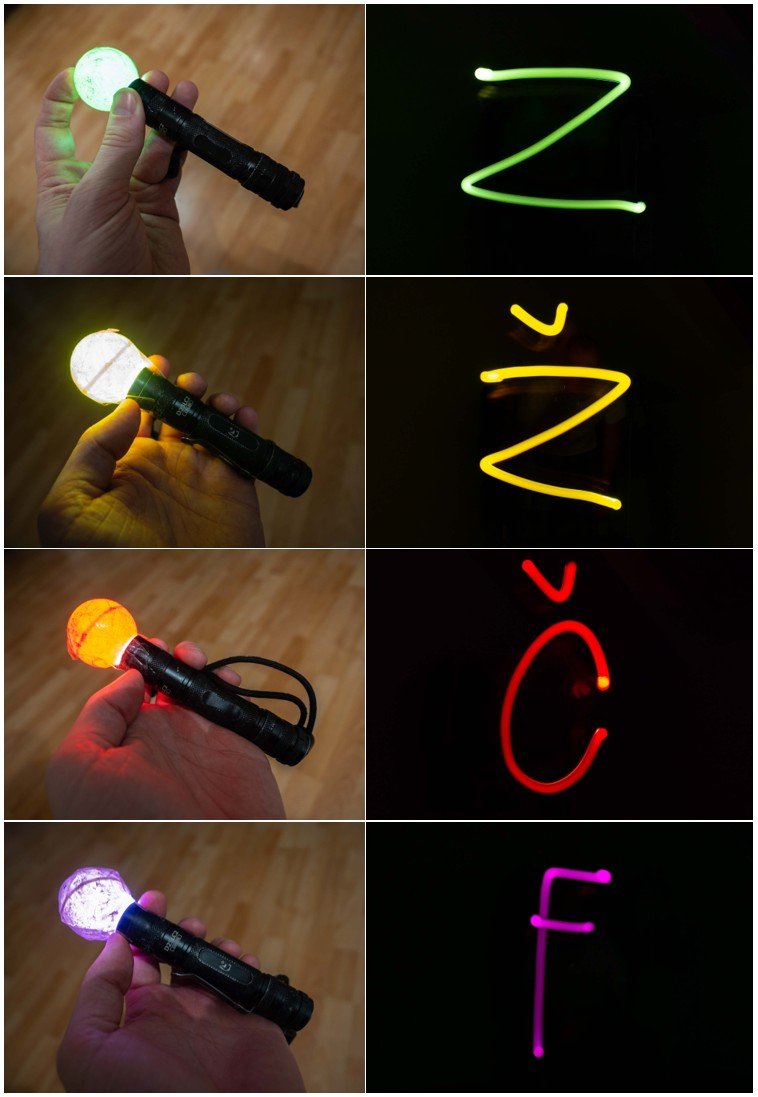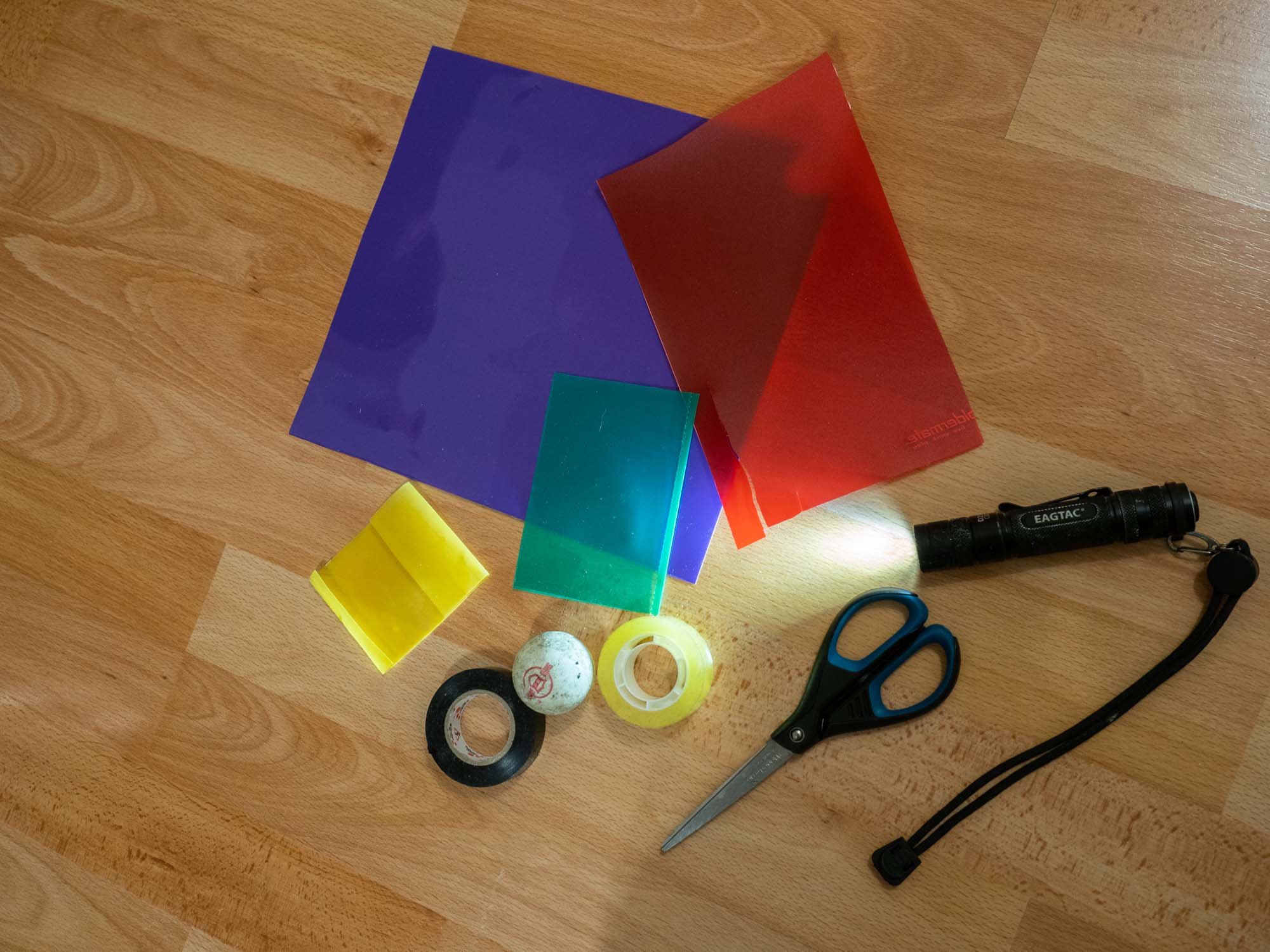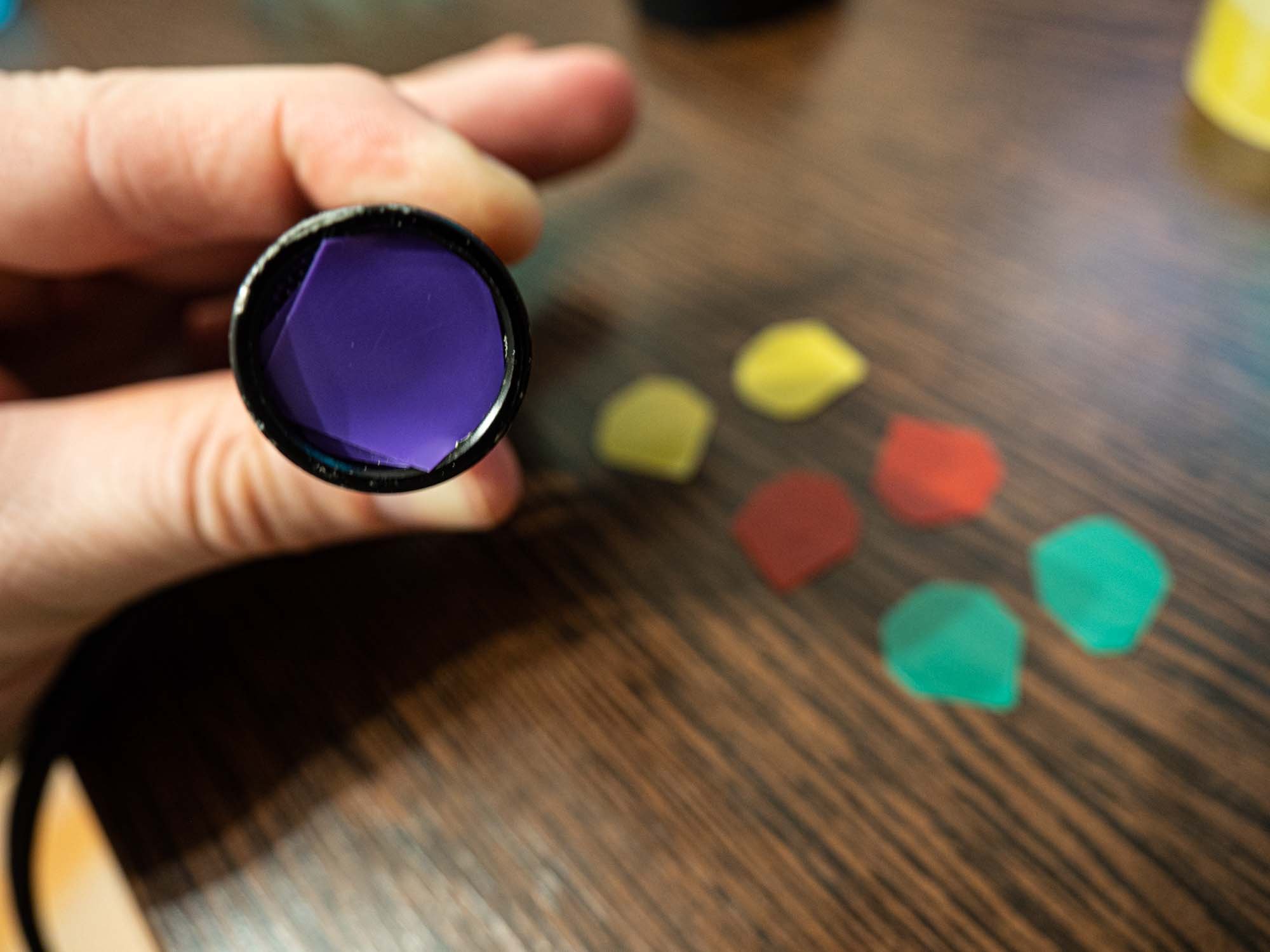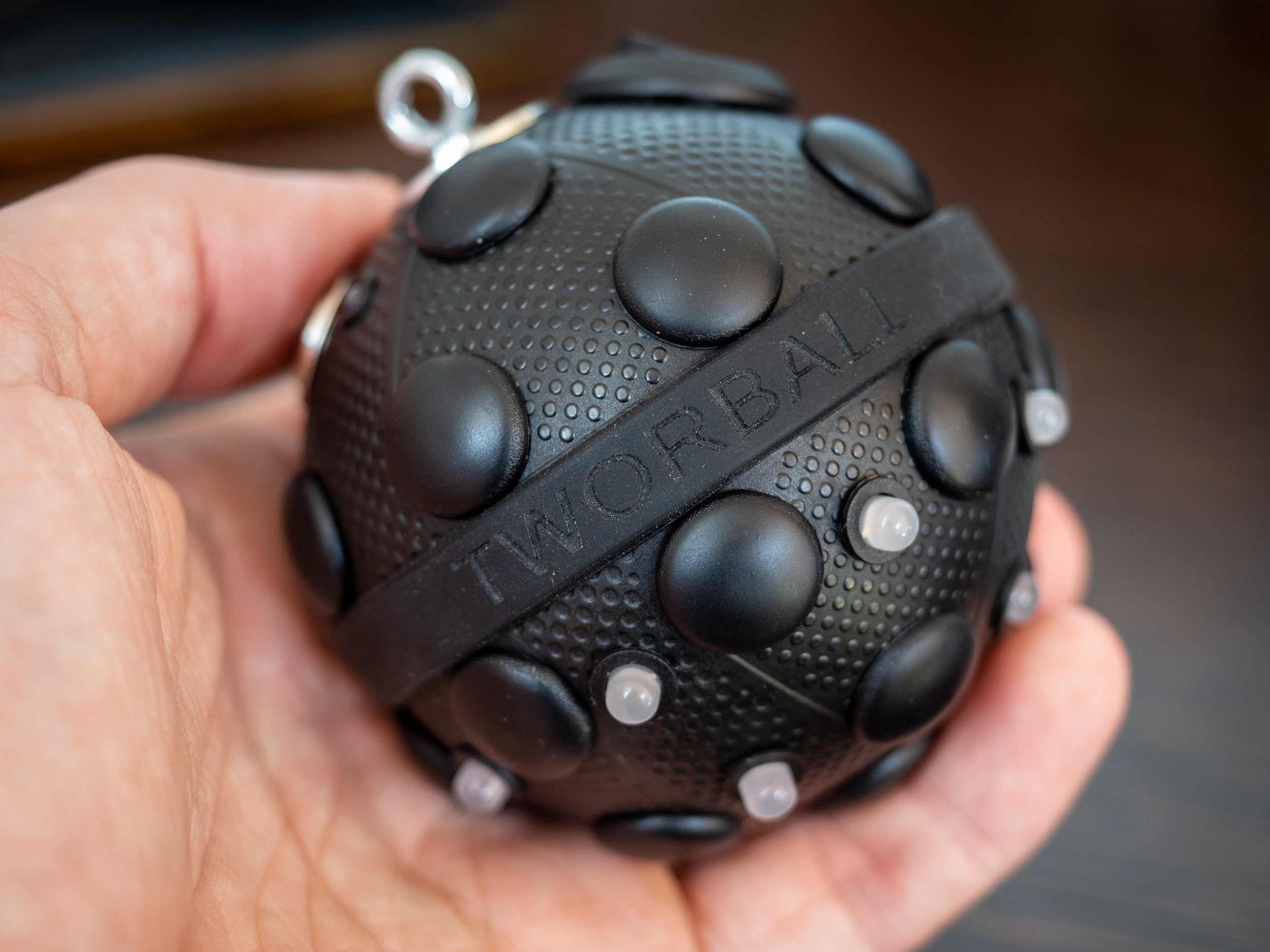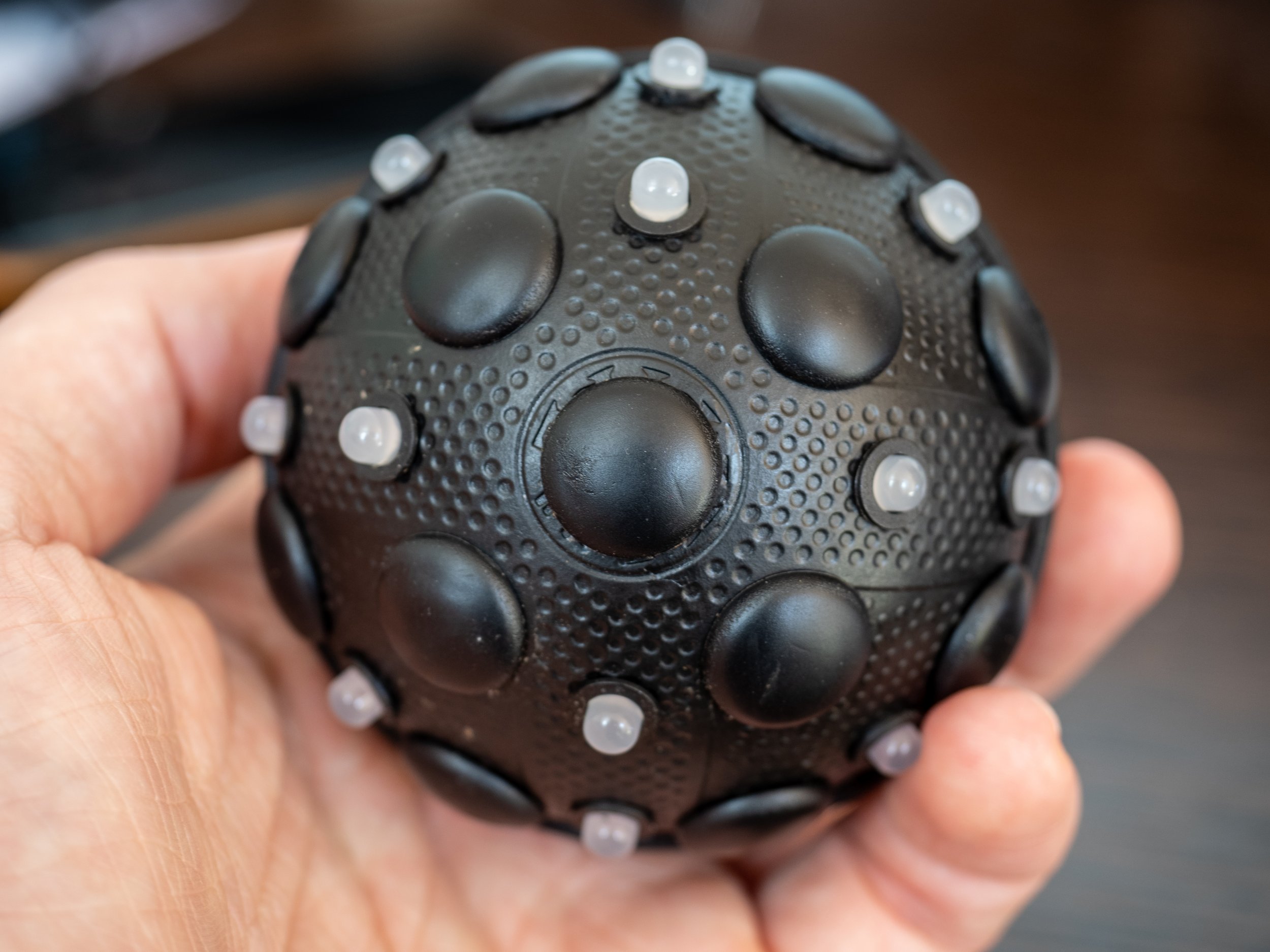Tworball
Depending on your imagination, a variety of tools can be used to create ORBs (ball of light). From the complete base such as an ordinary LED flashlight on a string through sparklers, lights for remote control or light bars to professional tools such as Orbtool and just the new Tworball.
LED light with a string, Orbtool and Tworball
To fully realize the undeniable benefits of Tworball, we need to quickly explain how other tools work.
Light on a string
Ping pong ball and plastic from Kinder Surprise on LED lamp
The complete base is an LED light on a string with an attached ping pong ball. As a tool, it is great and fulfils its purpose perfectly, but it also has a few hooks in the form of limited number of colours. LED flashlights are white as standard, the better ones are also red, green or blue and exceptionally UV, but that’s all. It is possible to extend the range of colours with the help of various colour filters, but these must be purchased, cut and always carried with you and changed whenever necessary. It is terrible, especially in winter, because it literally involves removing the attached ping pong ball from the flashlight, cleaning it from the rest of the duct tape, inserting a colour filter and attaching the ping pong ball back with duct tape. In addition, powerful lamps become relatively hot, so the colour filter, which is a thin plastic, twists sooner or later with heat.
Another limit is turning the lamp on and off. Since I have the flashlight on the string and I spin with it, it is difficult to turn it on and off so as not to destroy the light effect. There is a simple trick to help, but the controls are still not completely comfortable. Another limitation is the different flashing modes. Advanced flashlights can make a strobe mode, but again we get to the limitations of control, because during the rotation it is no longer possible to change the lighting mode. In conclusion, for more complicated compositions, this tool is not the best option due to the mentioned disadvantages, but as a basis for learning the ORB technique, it works perfectly.
Strobe mode
ORBTOOL
Orbtool and changeable heads
A huge step forward is the switch from a light on a string to a professional tool – Orbtool. It is a box containing a 9 V battery, with a control button, which can be used to adjust the light intensity. From the box leads a cable with a loop for gripping and at the end of the cable is an exchangeable head with LED diodes. This eliminates the problem of switching on and off, because it is possible to operate with the other hand. Nevertheless, it is necessary to learn the specific movement of the hand and the entire cable during rotation. The cable is fragile, it breaks quite often and the replacement is not cheap due to special terminals. Each exchangeable head has several LEDs with different colours, which are fixed on the heads and if I want a different colour than I have, I have to buy another head for 50 € and transfer from Australia.
Orbtool in action
As a result, I have 7 heads with several colours and it takes me a while to find the right one that I need. In addtion, they take up a lot of space in the backpack. In general, I am very satisfied with Orbtool, but nowadays it is no longer relevant in terms of comfort of use and the possibilities it offers.
Orbtool and castle Okoř
TWORBALL
Tworball
This is a brand-new device the size of a floorball ball with a remote control. The device carries 12 LEDs, divided into two channels, so it can light in one or two colours simultaneously. Colours can be changed as needed and more than 4 million colours can be displayed! Furthermore, it can handle 16 frequency strobe modes from slow to really fast. There are user modes, where I precisely define the function and when shooting I can switch freely between the individual user modes. Inside is a rechargeable battery that promises several hours of operation. I haven’t charged yet, so it looks like it’s going to last a long time.
The TWORBALL is the first RGB LED tool without PWM effect because the manufacturer has developed a special method for linear dimming of the LEDs. The disadvantages of pulse width modulation (PWM) with other tools were described by Sven Gerard in this article.
Distracting effect – there is NONE on Tworball
Body
Tworball is a device the size of a floorball ball with a diameter of 72 mm and a weight of 130 grams. There are rubber pins all over the body and there is also an on / off button, a loop for connecting a steel cable, a connector for charging and data transmission and a diode that indicates the status of the battery. The battery is a Li-Pol type with a capacity of 1000 mAh. Tworball also makes sounds to report various conditions, such as beeps when I have not noticed it for a long time or when I am in learning mode and also beeps when I select on the remote control. The audio signals are great mainly because I don’t have to visually examine if the change has really taken place. The whole thing gives a robust impression, it is not a cheap plastic. I have only one complaint about the charging connector, because it is not covered by anything at all. When shooting, I am sometimes outside even in bad weather and most of my equipment can withstand some water, but I am not able to do that with Tworball yet. I would welcome a rubber cover here. However, I have information from the producer that he is intensively looking for the right one.
Controls
The control is similar to the first variant of the light on the string, only instead of the string there is a steel cable and at the end there is a loop for two fingers. There is no need to learn special hand movement during rotation and the whole device can be controlled with the remote control in the other hand. The huge advantage is that the producer adjusts the length of the steel rope exactly to the height of my figure, so I can create a really large ORB at my two meters, because the device moves only a few centimetres above the ground.
Technical support
When I first used it outside, Tworball suddenly flew away while spinning a steel wire. At that moment, I almost had a heart attack, because I had no LED lamp with me, and it was completely dark around and now look for it somewhere. Fortunately, it flashed several times after falling to the ground, so I found it. A quick check showed that the device was working. The reason it flew away was an ordinary carbine, which somehow pulled out. It is still a mystery to me how this happened.
Old and new carbine
However, after coming home, I found out that some diodes are pressed in after the crash and one shone a different colour than the others, i.e. it had damaged contact. I contacted the producer, who immediately started to solve the whole situation. As a result, he replaces the carabiner with a better one with a screw cap and not only for me, but for all products for future sale. Furthermore, with the assistance of the producer, I was able to at least return LEDs to their original position, unfortunately I was unable to repair the one with wrong colour. However, the producer promised to come up with something and let me know.
Damaged LEDs
After about three weeks, I received a message from the producer that they would introduce a new firmware and that they would upload it into my device and at the same time repair damaged LEDs. It was an offer you cannot refuse! I sent him Tworball and to my surprise it was back in about a week, completely like new, fully functional and with new firmware.
Technical support works great!
Setting options
Tworball is a really powerful device – it has eight predefined basic colours and I am able to set any other colour to one of the four user modes. I get into the learning mode with a simple setting and with the help of RGB I choose the desired colour and save. It would be nice to have an app where I set the colour faster, so maybe in a future update. As I mentioned, Tworball has LEDs arranged in two separate channels, so you can use two different colours at the same time and a nice final effect can be achieved.
Remote controller
Another interesting mode is colour blending in eight steps. Basically, all eight steps are predefined first by one colour, then two colours alternate and the whole thing is repeated in a loop.
Colour mix
The great thing is that I can also set the blending speed in 16 steps. At the same time, I can stop the loop and switch between the individual steps manually. And as a complete bonus, I can define it all according to my ideas with a simple setting. Coincidentally, I also discovered that I can combine this function with a strobe, so the resulting effect is simply great.
Colour mix and strobe
The strobe is an important part of the world of light painters. But it is necessary to mention that it must be a regular strobe, nothing in the style of SOS flashing. Here again I can set the flashing speed in 16 steps. The lowest speed is 0.3 Hz, which corresponds to about 3 seconds and the highest speed is 10 kHz. This is such a speed that it lights up almost constantly and not even the camera can detect it. By default, the speed is set to 20 Hz, which flashes adequately, but you can save your preferred speed.
Strobe mode 1.25 Hz to 80 Hz, it goes up to 10 kHz
There are also buttons on the remote control for quick colour switching in individual channels, the resulting ORB is also a little different.
My impressions
Overall, I’m really excited about Tworball! There are many possibilities that can be used and, moreover, they can be freely combined. Currently (3/21) is not available on the market any device with such possibilities. the price is 170 EUR. Just check the website www.tworball.com.







